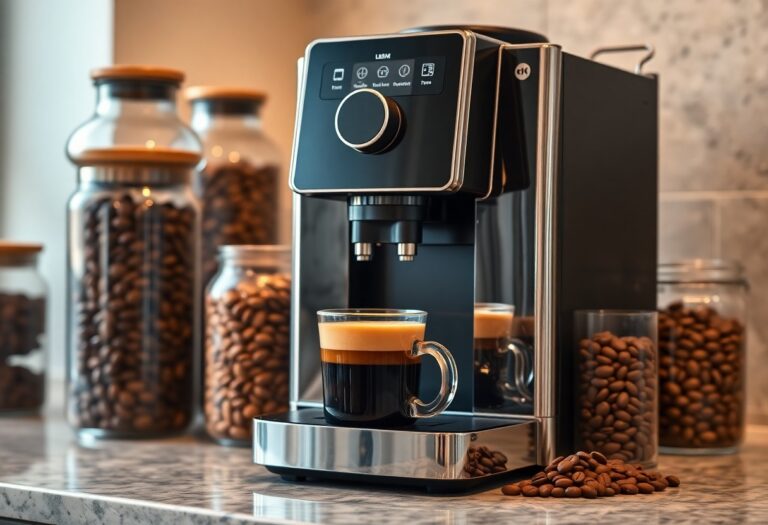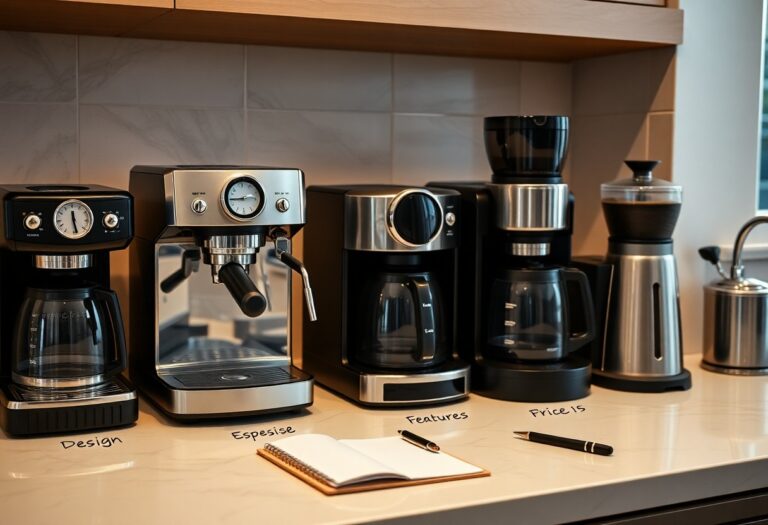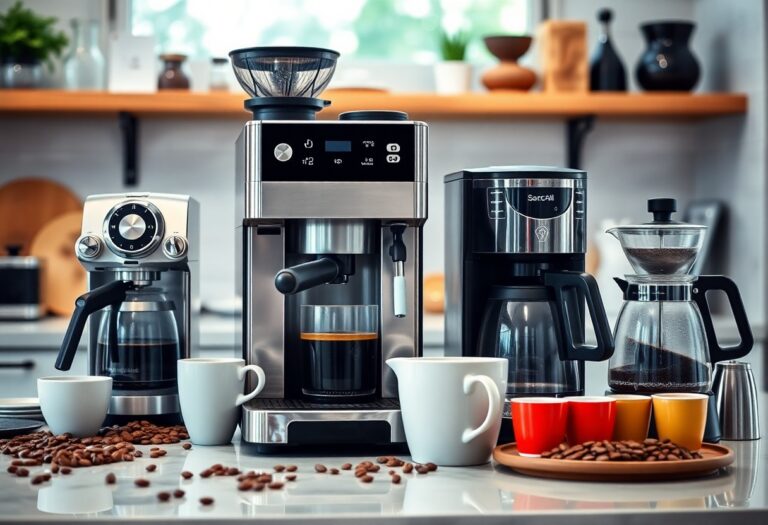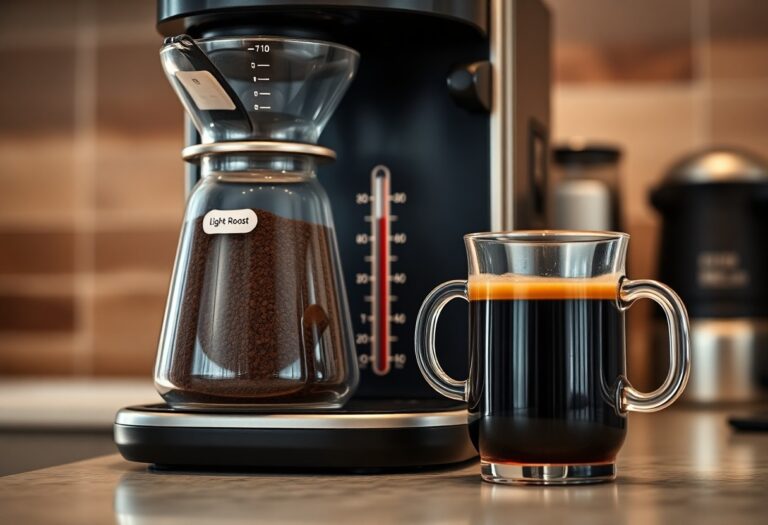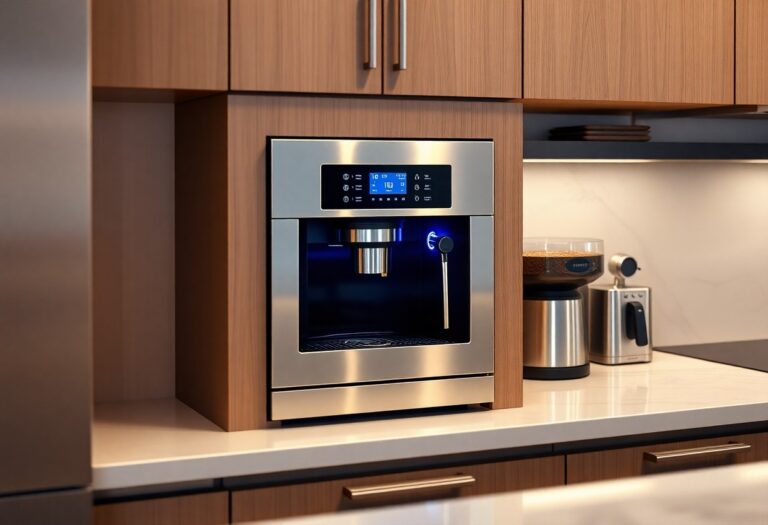What Type of Coffee Grind for an Espresso Machine – Fine Grinding
Many coffee enthusiasts wonder what type of grind you should use for your espresso machine, and the answer lies in fine grinding. A consistent and fine grind is vital for achieving the rich, bold flavors you expect from a quality espresso. Too coarse a grind can lead to a weak and under-extracted shot, while overly fine grounds might clog your machine, preventing proper extraction. Understanding the importance of grind size will elevate your espresso game, ensuring you fully enjoy the complex aromas and flavors in each cup.
Key Takeaways:
- A fine grind is necessary for producing the rich flavor and strong aroma characteristic of espresso.
- The grind size affects the extraction time; too fine may lead to over-extraction, while too coarse can result in under-extraction.
- Use a burr grinder for consistent fine particle size, which is important for achieving a balanced espresso shot.
- Experiment with grind size adjustments based on your espresso machine’s brewing conditions and coffee beans used.
- Preserve the freshness of your coffee grounds by grinding just before brewing to maximize flavor.
The Precision Required: Why Grind Size Matters for Espresso
Grind size directly influences the precision of espresso extraction. A fine grind ensures that water passes through your coffee grounds evenly, enhancing the flavor and aroma of your espresso. Larger particles can disrupt this balance, leading to uneven extraction and undesirable taste. The science of grinding includes factors like water temperature and pressure, which play a key role in the extraction process. For an in-depth exploration of the intricacies involved in espresso grinding, check out Espresso: The Grind.
The Role of Extraction in Espresso Quality
Extraction occurs when water interacts with coffee grounds, dissolving flavors and oils. This process is where grind size becomes integral—fine grounds promote efficient extraction, enabling rich, flavorful shots. Poor extraction, on the other hand, can result in either under-extraction (sour) or over-extraction (bitter) coffee, making the right grind necessary for exceptional espresso.
How Grind Size Influences Taste and Consistency
Grind size not only impacts flavor but also consistency in your espresso shots. Finer grinds yield a more concentrated flavor profile, enhancing sweetness and complexity. Conversely, inconsistency in grind size leads to uneven extraction, causing fluctuations in taste. For optimal results, aim for a uniform grind texture to achieve a balanced flavor and consistent aroma in every cup.
The relationship between grind size and flavor intricacy is profound. A uniform, fine grind allows for consistent extraction, producing a well-rounded espresso that highlights the inherent flavors of your beans. If the grind is too coarse, you will experience a watered-down, sour taste; too fine, and the espresso may turn bitter. Striking the right balance ensures that every shot delivers the depth and richness you expect from a quality espresso. Regularly calibrating your grinder can help maintain this balance, leading to consistently excellent coffee experiences.
The Ideal Grind: Achieving the Perfect Fine Texture
A fine grind is vital for extracting the rich, bold flavors that define a quality espresso. Achieving this texture requires attention to detail and a steady hand. The right grind size ensures that water passes through the coffee grounds evenly, maximizing flavor extraction while maintaining a creamy consistency. This results in espresso with a full-bodied taste and delightful crema, elevating your coffee experience. Fine grinding opens up a realm of flavor complexities that can transform your routine cup of coffee into a barista-level experience.
Characteristics of a Fine Coffee Grind
A fine coffee grind resembles granulated sugar, with particles that are small and uniform. This consistency allows for quick extraction, which is vital for brewing espresso in a matter of seconds. The small particles increase the surface area exposed to hot water, promoting a balanced flavor extraction. However, an overly fine grind can lead to over-extraction, resulting in bitter flavors. Striking the right balance is key to obtaining that velvety texture and aromatic profile in your espresso.
Tools and Techniques for Fine Grinding
Achieving a fine coffee grind requires specific tools and techniques, primarily focused on precision grinding. Using a burr grinder ensures an even grind size, as opposed to blade grinders, which can result in uneven particles. Burr grinders come in two types: flat and conical. Both types are capable of producing fine grounds, but conical burrs tend to generate less heat, helping maintain coffee freshness. Adjusting the grinder settings to the finest option is vital, as is regularly cleaning your grinder to avoid flavor contamination from old coffee residues.
Fine grinding techniques research beyond just the grinder you choose. The setting on your burr grinder plays a pivotal role—experimenting with slightly less fine settings may lead to the magical sweet spot for your particular beans. Some espresso aficionados prefer a technique called “dosing,” where they weigh out the coffee before grinding to ensure consistency. Regularly testing different beans can also yield an exciting variety of flavor profiles, allowing you to refine your technique and enjoy a truly personalized brewing experience.
Common Pitfalls: Missteps in Grinding for Espresso
Many homemade espresso enthusiasts fall into the trap of either under or over-grinding their coffee. Not adjusting the grind size appropriately can lead to weaker flavors or a bitter tasting shot. A fine balance is crucial for capturing the desired taste in your espresso. Regularly calibrating your grinder settings based on different beans and brewing conditions can save your espresso experience from bitter disappointment.
Overly Fine vs. Coarse Grind: Consequences on Brew
Choosing an overly fine grind can lead to over-extraction, resulting in a bitter, harsh flavor profile. Conversely, a too-coarse grind can result in under-extraction, yielding a weak and watery shot. Achieving the right grind size crucially captures a harmonious blend of flavors, ensuring your espresso is full-bodied and satisfying.
Equipment Choices: Matching Grinder Type to Espresso Machines
Your grinder type can significantly affect espresso quality. A burr grinder is often preferred over a blade grinder due to its ability to produce a consistent, uniform grind size, crucial for espresso brewing. Specifically, a flat burr grinder offers precision through adjustable settings, while a conical burr grinder allows for greater retention and a more versatile range of grinds. Investing in a high-quality grinder can enhance your overall espresso-making experience.
When selecting your grinder, consider that not every espresso machine requires the same type of grinder. If you own a high-end espresso machine with specific pressure and temperature controls, pair it with a professional-grade grinder that can match these parameters. Look for grinders with grind size settings tailored to espresso, as well as features like timed grinding or doser options, which can help manage the perfect dosing for your espresso shots. With the right combination, you can consistently produce exceptional espresso at home.

Fine-Tuning Your Espresso: Adjusting Grind for Variable Factors
Fine-tuning your espresso grind is crucial to achieve that perfect shot. Factors such as your coffee bean’s age, roast level, and even your brewing environment can significantly affect the taste and quality of your espresso.
- Adjust for freshness – Fresher beans require less fine grinding to maintain flavor profile.
- Optimize for roast level – Darker roasts may need a coarser grind.
- Consider dose adjustments – The amount of coffee you use impacts grind size; more coffee may require finer grinds.
Thou must pay close attention to these elements to refine your espresso experience.
The Impact of Bean Origin and Roast Level on Grind Choice
The origin of your coffee beans and the roast level directly impact your grind choice. Beans from differing regions showcase various flavor profiles, necessitating specific grind adjustments. For instance, a high acidity Ethiopian Yirgacheffe may shine with a finer grind to bring forward its delicate fruity notes, while a smoky, low-acidity Sumatra might benefit from a slightly coarser grind to balance its robust flavors.
Adapting to Environmental Conditions: Humidity and Temperature
Your brewing environment plays a significant role in how your coffee grind performs. High humidity can lead to clumping in coffee grounds, altering the extraction process. Conversely, low humidity can result in a drier grind, which may over-extract flavors during brewing and result in bitterness. Adjusting your grind size based on these conditions is crucial for achieving optimal results.
Impact of Humidity and Temperature on Espresso Grind
| Environmental Factor | Effect on Grind |
|————————–|————————————————-|
| High Humidity | Can cause clumping, requiring a slightly coarser grind for even extraction. |
| Low Humidity | May lead to a dry grind, necessitating a finer grind to avoid over-extraction. |
Incorporating environmental adjustments is vital for mastering your espresso. For example, during humid months, you may notice your grind clumping together, which disrupts your extraction process. Fine-tuning your grind size to a coarser setting can mitigate this issue, allowing for a more even extraction and a flavorful shot. Similarly, in dry conditions, fine-tuning toward a finer grind will improve the espresso’s overall balance and sweetness, as it helps to release more oils and soluble compounds during extraction.

Expert Insights: Barista Perspectives on Fine Grinding
Engaging with seasoned baristas reveals a wealth of wisdom regarding fine grinding for espresso. Many professionals emphasize that achieving the right grind size is not merely about equipment but also understanding the beans’ roast date, humidity, and even the machine you’re using. Adjustments are often required based on these factors, with experienced baristas routinely tasting and tweaking to hone their brews, ensuring that each shot captures the intended essence of the coffee.
Professional Recommendations from Top Baristas
Top baristas consistently recommend aiming for a grind size similar to table salt, which can contribute to optimal extraction and crema formation in your espresso. They advocate for a consistent grind, as variations can lead to uneven extraction, resulting in bitter or sour notes. Testing your grind size with different beans and adjusting based on sensory feedback allows you to fine-tune your espresso craft to perfection.
The Evolving Standards of Grinding Techniques in the Industry
The espresso coffee industry is witnessing continuous advancements in grinding technology and methods. High-quality grinders featuring burr systems allow for precise size adjustments, reflecting ongoing trends towards specialty coffee that demands exceptional flavor clarity. Baristas now embrace not just grind size consistency but also variable settings to adapt to individual bean characteristics. This evolution underscores the importance of embracing not only established techniques but also innovative practices for superior espresso.
The growth of specialty coffee shops pushes the envelope on traditional grinding techniques. Baristas now invest in state-of-the-art grinders that offer a range of settings, allowing for nuanced adjustments based on bean provenance and roast profile. This paradigm shift also encompasses educational workshops where experts share insights on grind techniques. Many now employ technologies to monitor grind consistency in real-time, ensuring every espresso shot meets stringent quality standards. As taste preferences evolve, these practices signify a commitment to excellence—and ultimately, a better coffee experience for you.
To wrap up
The key to achieving an excellent espresso lies in the grind size, with fine grinding being paramount for optimal extraction. You should aim for a consistency that resembles table salt, ensuring that your espresso machine can extract the full spectrum of flavors and aromas from the coffee. Investing time in perfecting your grind will greatly enhance your espresso experience, allowing you to savor every shot with depth and richness. Always keep in mind the importance of freshly ground coffee for the best results.
FAQ
Q: What type of coffee grind is best for an espresso machine?
A: For an espresso machine, a fine grind is typically recommended. This grind size allows for optimal extraction of flavors during the brewing process, producing a rich and concentrated espresso shot. The fine particles increase the surface area of the coffee, which helps ensure that water passes through effectively, extracting necessary oils and flavors more efficiently.
Q: How does grind size affect the taste of espresso?
A: The grind size significantly impacts the taste of espresso. A fine grind allows for a longer extraction time, which can result in a fuller-bodied flavor profile. If the grind is too coarse, the water will pass through too quickly, leading to a weak and under-extracted shot. Conversely, if the grind is too fine, it may lead to over-extraction, resulting in a bitter taste. Finding the right balance is key to achieving the desired flavor.
Q: Can I use pre-ground coffee for my espresso machine?
A: While it is possible to use pre-ground coffee in an espresso machine, it is generally recommended to use freshly ground coffee for the best results. Pre-ground coffee may not be ground to the optimal fine consistency for espresso and can lose its freshness and flavors over time. Grinding coffee just before brewing helps preserve its aromatic compounds and provides a better overall espresso experience.
Q: How fine should I grind my coffee for espresso?
A: A good guideline for grinding coffee for espresso is to achieve a consistency similar to table salt or fine sugar. The grind should be very fine, but not so fine that it clogs the filter basket or causes excessive pressure during extraction. It may take some experimentation with your specific espresso machine and beans to find the perfect grind size that suits your taste preferences.
Q: What equipment do I need to achieve a fine grind for espresso?
A: To achieve a fine grind suitable for espresso, a quality burr grinder is recommended. Burr grinders provide a uniform grind size and allow you to adjust the settings to achieve the desired coarseness. Blade grinders may not provide a consistent grind and can produce uneven particle sizes, which can lead to less effective extraction. Investing in a good burr grinder can significantly enhance your espresso brewing quality.


